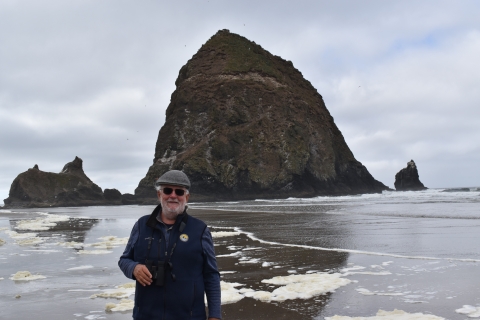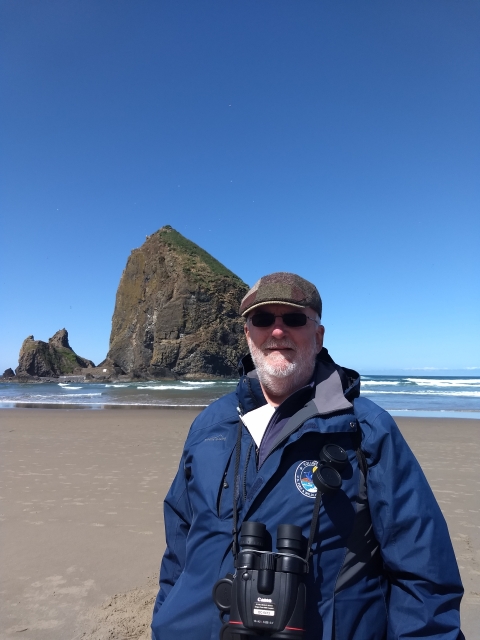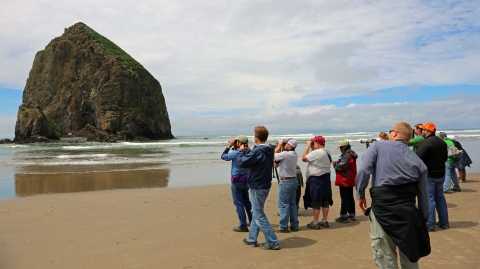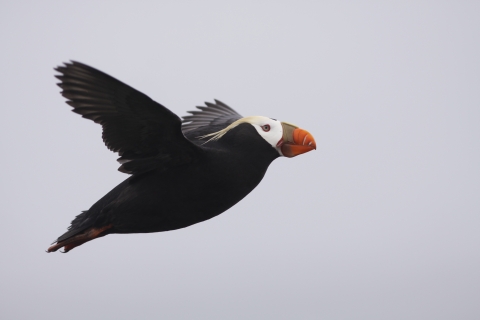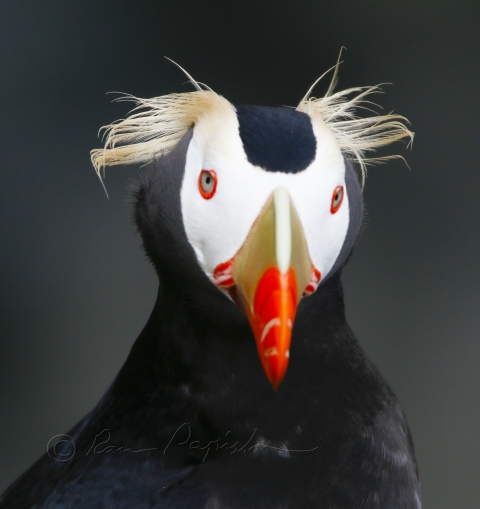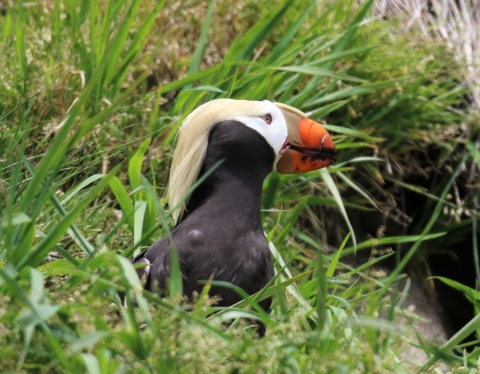By Taryn Sutton, former Visitor Services Specialist, Oregon Coast National Wildlife Refuges
“Do I really get to do this again today?” says Tim Halloran as he observes the tufted puffin colony at the famous Haystack Rock in Cannon Beach, Oregon. Halloran has held a strong love for nature throughout his life. He worked as a biology teacher, volunteered at the Field Museum in Chicago feeding the poison dart frogs, and educated people about sea turtles in South Carolina. It was no surprise that once Halloran and his wife moved to Oregon, he began volunteering with the Haystack Rock Awareness Program. The program is funded by the City of Cannon Beach, an important partner for the U.S. Fish and Wildlife Service.
Haystack Rock is protected as a part of the Oregon Islands National Wildlife Refuge, which is managed by the Service and spans the entire length of the Oregon coast. The wilderness islands and windswept headlands of the refuge are celebrated for their abundant wildlife, spectacular views, and rugged grandeur. Rocky islands and sheer cliffs provide isolated breeding and resting habitat for diverse communities of birds, marine mammals, and plants along the wave-battered coastline.
The Haystack Rock Awareness Program connects with thousands of visitors each year, educating the public about the iconic rock and refuge. As a volunteer, Halloran has taught thousands of people about the intertidal creatures around the rock and other marine life. But like many visitors, he was especially drawn to the charismatic birds that nest on Haystack Rock, the tufted puffin. A birder since 1969, being intrigued by these funny looking birds was a no brainer for Halloran.
When Halloran began volunteering for HRAP, he learned about a volunteer collecting data on puffins for the Service and sought him out to learn more. During their first conversation, the volunteer let Halloran know this would be his last year and they needed a replacement to continue the research. In 2012, Halloran took their place and began volunteering for the Service as the official tufted puffin observer at Haystack Rock. In 2024, after 12 years in this incredible position, Halloran stepped down.
Tufted puffins have been rapidly declining in Oregon, from 5,000 birds in 1998 to just 553 in 2021. The second largest nesting population in the state is at Haystack Rock, and in 2010 the Service began monitoring the rock’s tufted puffin population. There were 127 individual birds in 2010, and this past summer the rock supported 102 birds. The decline of tufted puffin populations doesn’t just affect Oregon. Over the past 20 years, the population has declined across the species’ range - from British Columbia to Northern California. Factors that could be causing the population decline include conditions at breeding sites, changes in food availability, winter survival, and more. Tufted puffins are currently listed as a sensitive species by the Oregon Department of Fish and Wildlife due to the multiple threats faced by their population and habitat.
When Halloran was on the beach with a spotting scope, beach goers always asked what he was doing. That was his opportunity to educate others about his work as a citizen scientist collecting data and about the birds protected by the refuge. Halloran has also been featured on an episode of Oregon Field Guide about the tufted puffins of Haystack Rock. He thought they did a wonderful job showcasing all the work being done to help protect the birds. Over the years, through all these efforts, Halloran has certainly earned his nickname, the “Puffin Man.” Halloran’s presence will be missed on the beach, but his legacy will continue through the tufted puffin data he collected as a citizen scientist and the people he met as a volunteer.
If you are planning a trip to Haystack Rock, Halloran has some tips on tufted puffin viewing:
- The best time to spot puffins are the two hours in the early morning just after sunrise and two hours before sunset. This is when puffins are most active, out of their burrows and searching for food.
- He says, “You can differentiate the puffins from other birds because they look like flying footballs with a solid black belly.”
- He looks for the birds as they fly and follows them to see where they land on the rock, which is typically near their burrows. The puffins dig a tunnel in the soil that can be up to seven feet. One egg per year is laid which offers challenges for the species to repopulate with such a small clutch size.
If you are interested in volunteering with the Service, please reach out to Dawn Harris, Visitor Services Manager, at dawn_harris@fws.gov.
